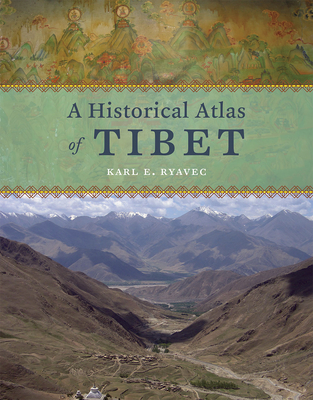
A Historical Atlas of Tibet
Description
Cradled among the world’s highest mountains—and sheltering one of its most devout religious communities—Tibet is, for many of us, an ultimate destination, a place that touches the heavens, a place only barely in our world, at its very end. In recent decades Western fascination with Tibet has soared, from the rise of Tibetan studies in academia to the rock concerts aimed at supporting its independence to the simple fact that most of us—far from any base camp—know exactly what a sherpa is. And yet any sustained look into Tibet as a place, any attempt to find one’s way around its high plateaus and through its deep history, will yield this surprising fact: we have barely mapped it. With this atlas, Karl E. Ryavec rights that wrong, sweeping aside the image of Tibet as Shangri-La and putting in its place a comprehensive vision of the region as it really is, a civilization in its own right. And the results are absolutely stunning.
The product of twelve years of research and eight more of mapmaking, A Historical Atlas of Tibet documents cultural and religious sites across the Tibetan Plateau and its bordering regions from the Paleolithic and Neolithic times all the way up to today. It ranges through the five main periods in Tibetan history, offering introductory maps of each followed by details of western, central, and eastern regions. It beautifully visualizes the history of Tibetan Buddhism, tracing its spread throughout Asia, with thousands of temples mapped, both within Tibet and across North China and Mongolia, all the way to Beijing. There are maps of major polities and their territorial administrations, as well as of the kingdoms of Guge and Purang in western Tibet, and of Derge and Nangchen in Kham. There are town plans of Lhasa and maps that focus on history and language, on population, natural resources, and contemporary politics.
Extraordinarily comprehensive and absolutely gorgeous, this overdue volume will be a cornerstone in cartography, Asian studies, Buddhist studies, and in the libraries or on the coffee tables of anyone who has ever felt the draw of the landscapes, people, and cultures of the highest place on Earth.
Praise for A Historical Atlas of Tibet
“Following two decades of research, Ryavec expertly presents the historical and cultural transformations of Tibet since the Palaeolithic period through a series of forty-nine maps supplemented by detailed keys, essays, and accompanying photographs. The first work of its kind, A Historical Atlas of Tibet is a beautiful reference book of value to a range of scholars and students including historians, anthropologists, historical geographers, and digital cartographers.”
— Tim Chamberlain
“Ryavec, an American academic and trained geographer, spent over a decade on this ambitious project, laboring to capture Tibet’s full majesty in cartographic form. Through his forty-nine gorgeous maps, plus many vivid photographs and illustrations, Ryavec presents us Tibet from the prehistoric to the imperial to the modern eras, delving into the languages, natural resources, administration, and religion of the entire region. . . . Will enchant and inform any lover of maps.”
— Dan Zigmond
“With the proliferation of high-quality online cartographic resources, it sometimes becomes necessary to defend, or at least explain, the value of printed atlases. A Historical Atlas of Tibet is a wonderful answer for doubters. Ryavec offers a well-researched, beautifully executed work with a useful introduction showing maps of major regions, current political boundaries, and natural features. The material provides context for readers (especially those with limited knowledge of the region) and illuminates material covered in later chapters. One especially interesting map is ‘Travel Time from Lhasa in Weekly Increments.’ The simple concentric circles of this graphic and the text describing it efficiently and effectively convey the limitations of travel in this mountainous area. Four chapters, each covering a specific time period, make up the bulk of the atlas. Maps within shed light on the history of Tibet through changes in territorial administration, distribution of cultural and religious sites, and other spatial phenomena. Text accompanying maps guides readers through the information presented. Ample photographs of cultural sites, landscapes, and historical artifacts enliven the book. This terrific example of the synthesis of historical research and cartography is well cited throughout, providing an excellent introduction to the region's history and a companion to related textual works. . . . Highly recommended.”
— Choice
“A rich and informative reference work, an essential addition to the shelves of any Tibetologist, historical scholar of Tibetan Buddhism, or indeed historian of China, and the rewarding focus of many hours of study.”
— Mountain Research and Development
"Ryavec’s book not only provides geospatial coordinates for religious and cultural sites in Inner and East Asia; it also employs the full mapmaker’s toolbox to spatialize and temporalize population, language, and natural resources. In the richly illustrated pages of this unique and overdue contribution, readers see Buddhist life as just one component part of an entire physical, cultural, political, and economic topography."
— Religious Studies Review
“This is, quite simply, an incredible advance for Tibetan studies and Asian studies in general. Nothing of the kind exists elsewhere—these easily readable, beautiful maps are a tremendous contribution, for their scope and ambition, and for the innovative approach their maker has taken with them, such as the fascinating incorporation of long-scale timeframes. The result is one of the most up-to-date overviews of Tibetan history, grounded by a deep familiarity with primary and secondary data and distilled into a gorgeous format.”
— Gray Tuttle, Weatherhead East Asian Institute, Columbia University
